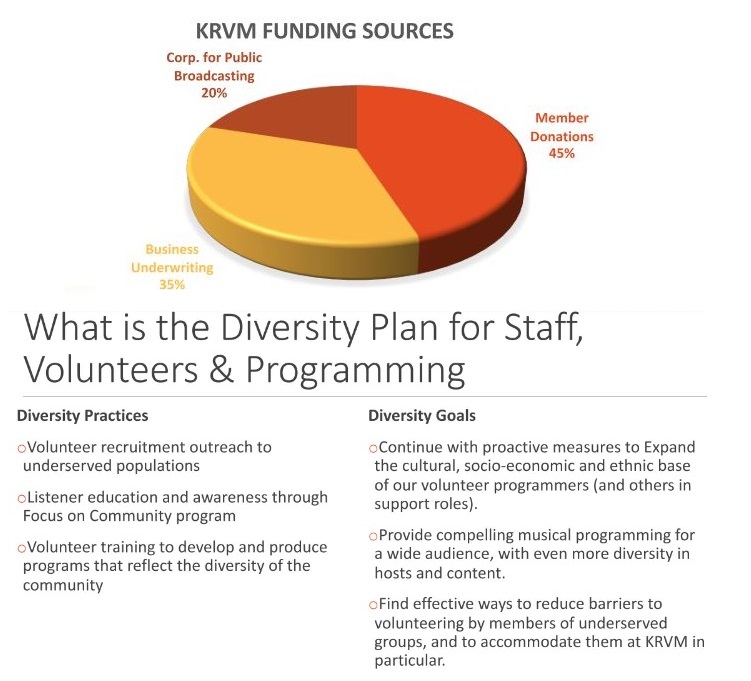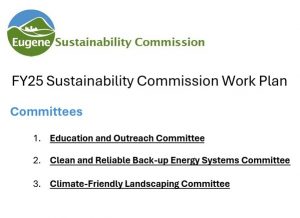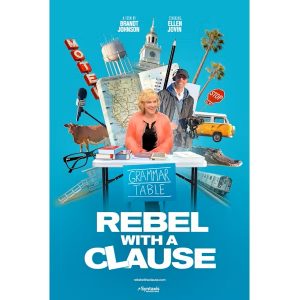New school board members urge more diversity at 4J’s KRVM
4 min read
4J Board members Laural O'Rourke and Maya Rabasa 'nudged' KRVM to consider providing more diversity and offering more opportunities for journalism experience.
This month, the district’s radio station presented its diversity plan to the school board.
[00:00:07] Chair, Judy Newman: Our first item for information is an update on KRVM radio program and diversity plan. Stuart Grenfell, the KRVM general operations manager.
[00:00:19] Stuart Grenfell: Our diversity goals include the student broadcast program, a wide variety of all sorts of socioeconomic, ethnic, different social groups. It’s amazing watching the kids…we do outreach to various groups in the community relationships and underserved populations.
[00:00:37] Laural O’Rourke: Speaking of diversity and inclusion and working on that, it would be really helpful to hear specifically what that means to you, because those are great. I’m not singling out you because the majority of humanity does this talking points and saying of words, but really knowing what they mean and having the data and the numbers. And it’s very helpful to see what that actually means and to see if every, you know, because to different people it means different things.
[00:01:10] John Q: Mike Meyer spoke at the next regular board meeting.
[00:01:13] Mike Meyer: I wanted to come in on a presentation from KRVM presenting about diversity and I was with KRVM for over 20 years and their lack of diversity was galling. And if they were administering diversity, they wouldn’t need to make such a presentation. KEPW does diversity as a natural thing that community radio does. They have BIPOC programming. They have youth programming and KRVM for over 70 years has been getting older and whiter and their student broadcasting program has almost gone away.
Thank you for supporting
local citizen journalism
And the board needs to intervene and get some management on KRVM that respects the community; that doesn’t allow for continuing hours of programming where you never hear one female; where it’s white males, older and older, doing the programming for a nostalgia station on a school district station.
And that is incongruent with your mission. It’s incongruent with respect for our community, and we need a diverse community space, especially now, and it needs to be on the airwaves. And KRVM is about as un-diverse as you can get, right, for any organization in this community. And it’s propaganda that they presented last time, they are good at selling things. They’ve been doing it for over 70 years and they have corporates now, management people, corporate backgrounds, and you put them there. And community radio doesn’t operate from a corporate lens. It operates from a social justice lens and from a diversity standpoint in our community. And again, KEPW does this easily, thoroughly, all day long and KRVM would, if they weren’t getting in their own way and controlling the airwaves by the same 70- and 80-year-old white men.
[00:03:09] John Q: At the work session, Board member Maya Rabasa.
[00:03:12] Maya Rabasa: I’m really excited about your presentation today. I love KRVM. My radio dial in my car is either KRVM or KLCC and one of the things that I think is super valuable about this resource is what Laural was touching on in terms of the opportunity for students to have access to, being exposed to this, not just volunteer, or something that they’re doing in school, but for future work as well.
The journalism students are at Network Charter School where they develop pretty well-developed podcasts. And I know my son, for example, took two terms of sound engineering, and I wonder if it were able to be incorporated into those types of learning spaces, the chance to come and see and have hands-on experiences, if it might be a spark potential for students.
I do appreciate what you’re sharing with us about your diversity plan. And I want to just nudge you a little bit to maybe even dive a little deeper. I see that you have seven programs that you’d designate as targeting diverse audiences. And then I was looking at the list of the programs and it feels as though it might be worthwhile putting some proactive measures into asking the hosts of things like Vinyl Revival or Sixties Beat, places where there’s room for diversity. And I’m just curious why they’re not included in those categories. And if they’re not, because it’s not traditionally, it doesn’t traditionally go beyond, um, you know, let’s just lay it out there: a pretty white audience. If we could maybe look to including that in your diversity plan.
And then my other question: I’d love to hear about your outreach efforts to the underserved populations and also it says “find effective ways to reduce barriers to volunteering by members of underserved groups.” And if that is something that hasn’t been worked on to the point where you have listed effective ways that perhaps you, maybe reach out to some of the local agencies that serve those communities, to find out about getting in touch with the communities that they work with.
[00:05:29] John Q: Many groups in the community can help as we learn to be more welcoming.



